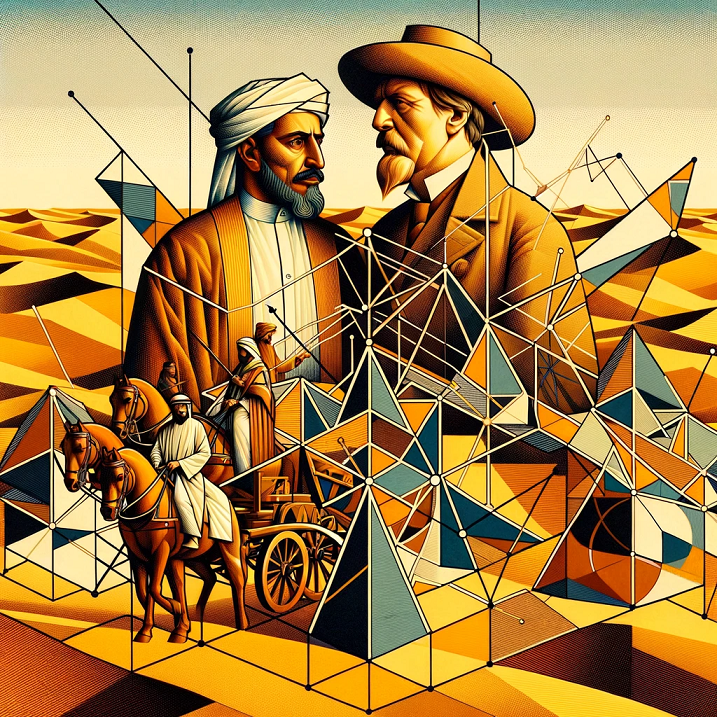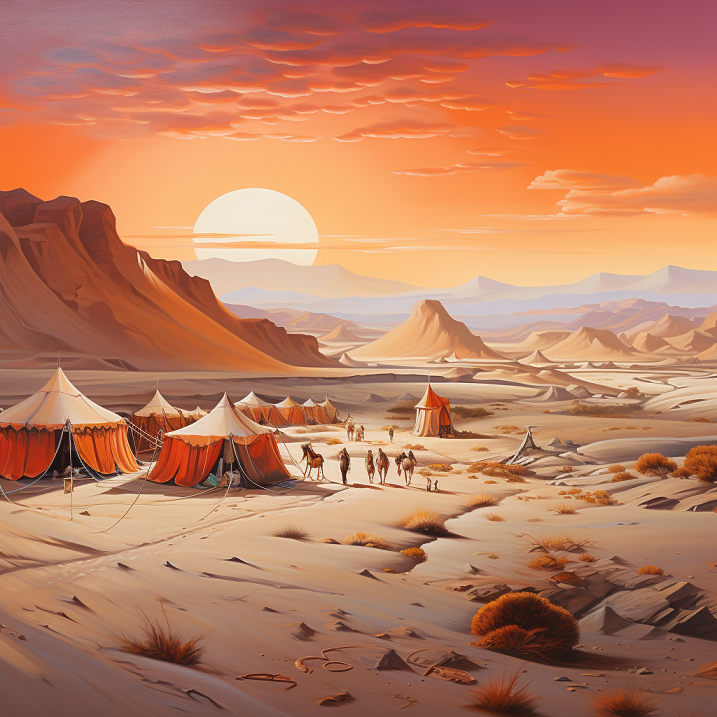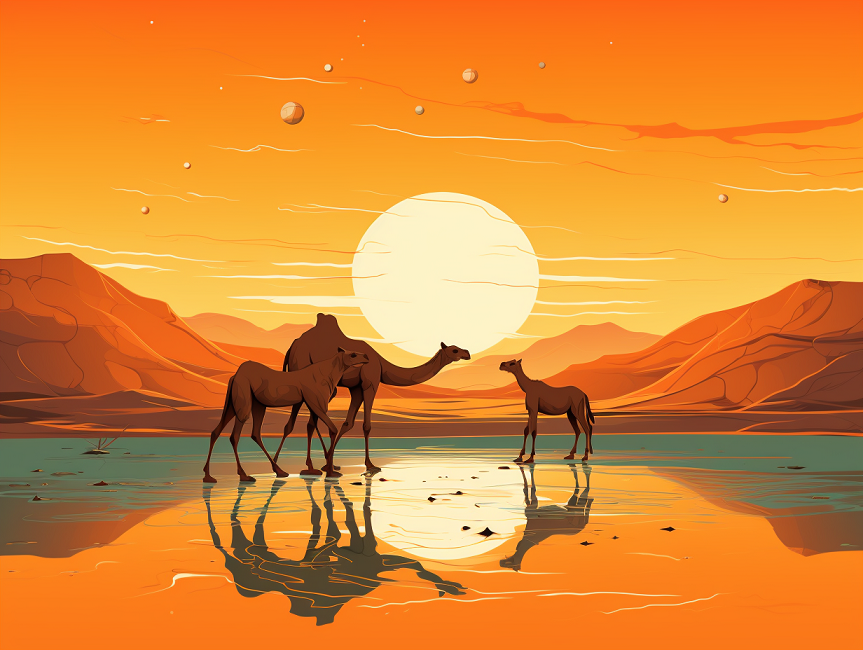Colonel Harold Richard Patrick Dickson, in his introspective account “My Life in the Desert,” humbly positions his narrative among the illustrious works of Arabian scholars such as Charles Doughty, Alois Musil, St. John Philby, and Bertram Thomas. Despite the vast knowledge these giants have contributed, Dickson embarks on sharing his unique and personal experiences, driven by the belief that his seven-year sojourn among the Bedouin of the Euphrates — specifically the Muntafiq and Khazail Arabs — and his subsequent political tenure in Bahrain, Hasa, and Kuwait, have endowed him with rare insights into a people he describes as “perhaps more lovable than any other race on earth.”
Key Takeaways
- Colonel Dickson’s narrative offers a unique and personal glimpse into the Badawin culture.
- His integration into the Badawin life was deepened through a shared lifestyle and understanding.
- Desert life is intricately connected to nature, marked by seasonal migrations and communal living.
- Dickson’s camp setup reflects a commitment to living and understanding the nomadic lifestyle.
- Daily life in the desert involved a blend of political work, cultural activities, and family life.
- The Badawin family represents a microcosm of the larger nomadic society, with each member playing crucial roles.
- Women in the Badawin community are pivotal, holding various roles from caregivers to cultural bearers.
- Dickson’s observations provide valuable insights into the wisdom and traditions of the Badawin.
- The narrative concludes with a reflection of gratitude and deep respect for the Bedouin people.
His narrative is not merely an account of an observer, but that of an active participant in the nomadic Bedouin life. Dickson’s deep immersion into the culture, facilitated by his fluency in Arabic and a sense of kinship established through “milk-brotherhood” with the ‘Anizah tribe, allowed him an unparalleled depth of understanding. This profound connection is further underpinned by the respect and admiration he developed for the Bedouin, whose life he not only observed but lived, moved, and camped among as one of their own.
Camping in Kuwait’s Deserts
In the stark and undulating expanses of Kuwait, Dickson embarked on a tangible commitment to understanding the Bedouin by setting up traditional black tents, the emblematic dwellings of the nomadic tribes. In May 1929, with the aid of Salim al Muzaiyin, a Mutair tribesman of Kuwait, Dickson inaugurated his descent into the desert way of life.
Dickson’s narrative takes us through the intricate details of desert camp life, from the selection and handling of these black tents to the seasonal movements dictated by grazing needs and tribal affiliations. His family, too, became an integral part of this life, spending successive winters amidst the sands and stars. The locations varied from the lush springs of Araifjan, a district south of Kuwait known for its abundance of grazing and flowers, to the far-reaching southern corners of the Kuwait Neutral Zone, indicating a life led by the rhythm of nature and the migratory patterns of the tribes.
Seasonal Patterns
With each winter, a pattern of life emerged, one marked by the pitching of tents amongst different tribes such as ‘Ajman, ‘Awazim, and Mutair. Dickson’s approach was one of fluid adaptation, never dictating the specific whereabouts or tribal associations for their camp. This flexibility and trust in local knowledge underscored his deep respect for the Bedouin way of life and his desire to immerse himself authentically within it.

Daily Life and Observations
Amidst the undulating dunes and under the vast, star-lit sky, Colonel Dickson’s life with the Bedouin unfolded in a rhythm dictated by the desert itself. His narrative vividly portrays the diverse activities and the richness of daily life in the camps. Collecting wild flowers for Kew Gardens in London and insects for the South Kensington Natural History Museum were among the pursuits that infused his days with purpose and curiosity. These activities, while serving scientific and botanical interests back in Britain, also symbolised the deep connection and contribution to the broader world that Dickson and his family were making from their isolated desert dwelling.
Desert Diplomacy
Political work and maintaining relations with neighbouring shaikhs from Saudi Arabia or Iraq were also integral to Dickson’s role in the desert. His account sheds light on the intricate web of tribal politics and alliances that he navigated with acumen and respect. This political engagement was not merely a duty but a means to stay abreast of the Bedouin news, understanding the undercurrents that moved across the Arabian landscape.
Hobbies & Past times
When not engaged in work or scholarly pursuits, Dickson and his wife indulged in the traditional pastimes of the desert. Hawking the lesser bustard, shooting sand grouse, and riding camels were activities that not only provided recreation but also deepened their understanding of the desert environment and its inhabitants.
The evenings brought their own magic. Around the campfire, a space of communal gathering and storytelling, Dickson would engage in conversations with men, women, and children of the camp, delving into discussions about raids, weather, grazing, and the many facets of desert life. This time provided a golden opportunity for cultural exchange and learning, allowing Dickson to ask questions and absorb the wisdom and stories of the Bedouin.
The Bedouin Family and Relations
In the heart of the desert, Colonel Dickson’s life was intimately woven with that of his Bedouin family. He introduces us to a constellation of individuals, each with distinct roles and personalities, who collectively embody the spirit and resilience of desert life. At the centre of this familial tapestry is Salim al Muzaiyin, the head of the Bedouin family and a Mutairi tribesman. Salim is portrayed as a paragon of the Bedouin virtues — respected for his honesty, stability, and extensive knowledge of the land. His wide respect in the community and regular visits to Riyadh indicate his significant status and the trust placed in him by Dickson and others.
The narrative unfolds to reveal other vivid characters: Maziad, a Dhafir tribesman and desert fighting man; Dhuwaihi, the blind old man and spiritual leader of the camp; and a constellation of herdsmen, shepherds, and family members who make the desert their home.
Among these individuals, women hold a place of honour and importance. Dickson gives special attention to the women of the camp, describing their charm, strength, and the critical roles they play.
The description of the Bedouin family extends to their daily activities, cultural practices, and the social dynamics within the camp. From the preparation of food to the weaving of tents and the caring for animals, every aspect of life is shared and communal.
Desert Lore and Cultural Insights
In the expansive openness of the desert, Colonel Dickson absorbed a wealth of knowledge and cultural insights that only immersion and close observation can provide. His narrative is rich with descriptions of the daily round of the Bedouin family, the care of their animals, and the myriad of survival strategies employed in the harsh desert environment. He meticulously documents the ways in which the Bedouin water their camels, horses, and sheep, revealing a life rhythmically tied to the needs of the herd and the availability of resources.
Dickson’s account is participatory just as much as it is observational. He doesn’t just watch but engages, asking perpetual questions, thereby deepening his understanding of the Bedouin’s intricate relationship with their environment. His inquisitive nature and the evenings spent around the campfire become a conduit for cultural exchange.
Dickson’s portrayal of the Bedouin’s desert lore and cultural insights offers a vivid picture of a people intimately connected to the land they inhabit. It reflects a way of life that is both ancient and adaptive, steeped in tradition yet continuously evolving in response to the challenges of the desert environment. Through his detailed account, Dickson provides a valuable perspective on the Bedouin of Kuwait, one that goes beyond the stereotypical portrayals to reveal the depth, complexity, and dignity of their culture and way of life.
Reflections
Colonel Dickson reflects on the years spent among the Bedouin as some of the most enriching and contented of his life. He paints a picture of a period marked by deep personal growth, understanding, and a profound respect for the Bedouin way of life. His reflections are a heartfelt homage to the people who had become much more than subjects of his study — they had become his friends, his family, and his teachers.

Dickson’s narrative affirms the endearing qualities of the Bedouin people — their hospitality, resilience, and the strong sense of community that he was privileged to be a part of. He speaks to the unique bond he formed with the desert and its inhabitants, a bond that transcended his role as a British political agent and allowed him to immerse himself fully in the Bedouin culture.
FAQs
Q: What is the primary focus of Colonel Dickson’s narrative?
A: The narrative focuses on Dickson’s experiences and observations of Badawin life.
Q: How did Dickson integrate into Badawin culture?
A: Through living and camping among the Badawin, adopting their lifestyle and language.
Q: What activities did Dickson engage in while living in the desert?
A: He collected flora and fauna, engaged in political work, and participated in traditional hunting and social activities.
Q: Who are the key figures in Dickson’s Badawin family?
A: The family is led by Salim al Muzaiyin and includes various members, each with distinct roles.
Q: What roles do women play in the Badawin community?
A: Women are crucial in maintaining the household, cultural traditions, and as knowledge bearers.
Q: What kind of insights does Dickson provide about the Badawin?
A: Insights into their daily life, cultural practices, and the close relationship with the desert environment.
Q: What emotion does Dickson express in his concluding reflections?
A: He expresses gratitude and respect for the Badawin and reflects on the deep connections formed.

